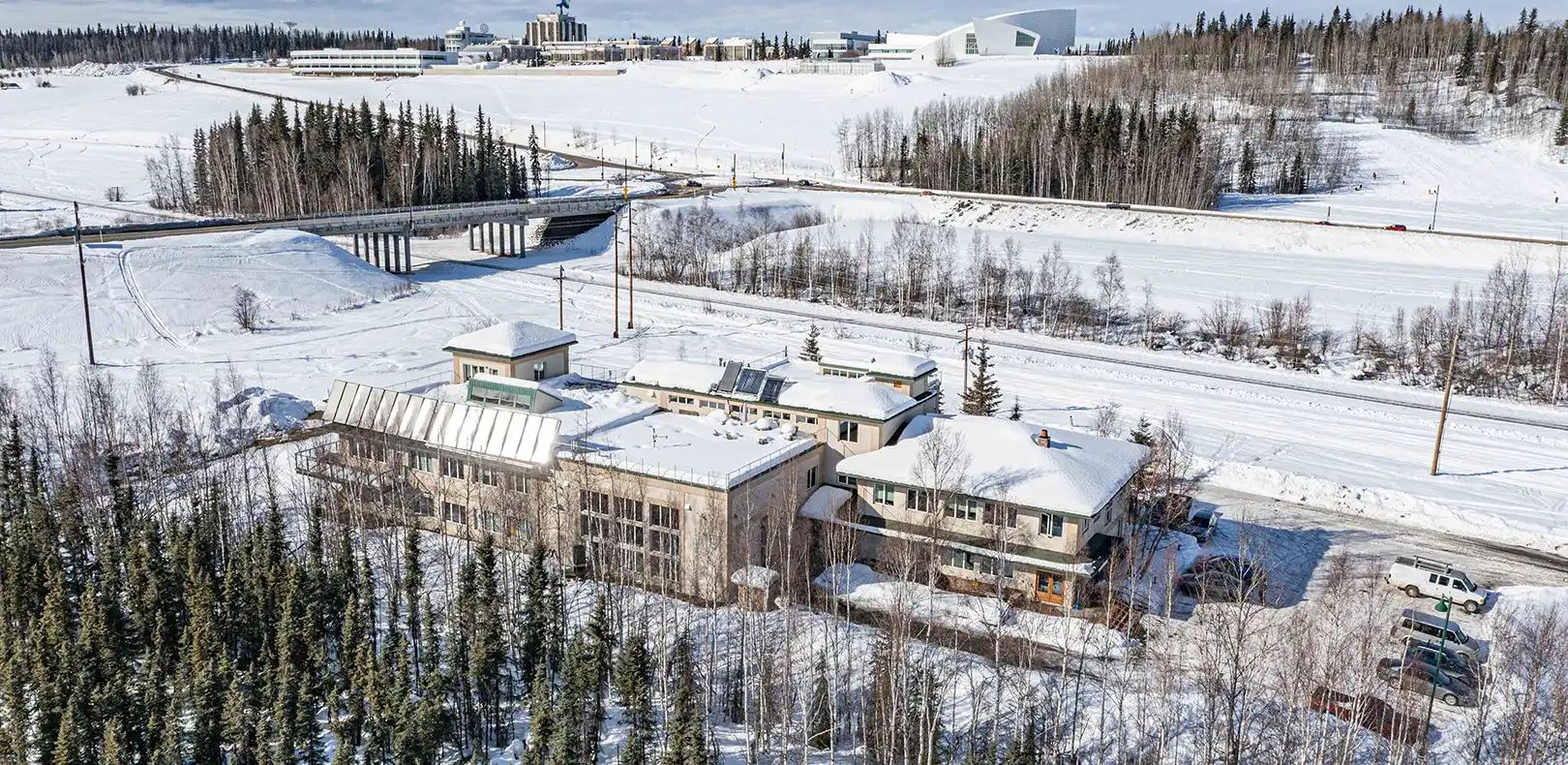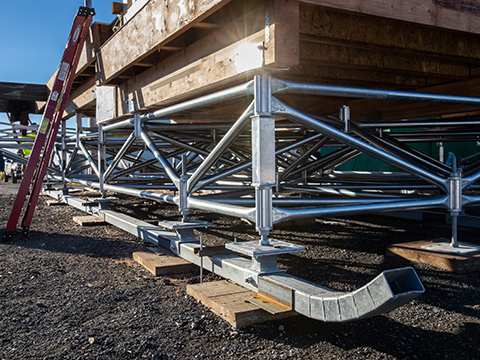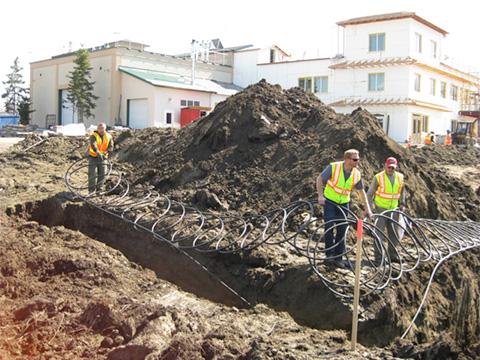Extreme Climates
At its northern campus in Fairbanks, Alaska, NLR works to enhance energy security and resilience in extreme environments.

NLR's Alaska Campus in Fairbanks integrates geothermal, biomass, solar, thermal storage, and advanced energy efficiency technologies to create energy stability in an extreme subarctic climate.
NLR's Alaska Campus in Fairbanks: A Living Laboratory in the Subarctic
Alaska offers some of the most extreme and varied environments on Earth, from Arctic tundra to temperate rainforests. The demands of the environment, combined with the innovation of northern residents, have helped make Alaska a leader in energy efficiency technologies.
NLR's Alaska Campus in Fairbanks works with industry, government, and communities to incorporate energy-efficient design into disaster response, military facilities, commercial buildings, and housing. Researchers have a long history of co-developing technologies with communities to ensure they incorporate local knowledge and meet the unique needs of users. Designs are evaluated in the lab before deployment to ensure they are durable, resilient, and affordable.
Focus Areas
NLR's research focuses on four key areas:
Building Envelopes
Buildings use 40% of all energy in the United States. In Alaska, 80% of energy use goes toward heating buildings. NLR's Alaska Campus designs super-insulated buildings that balance energy efficiency, health, and durability. Building technologies are developed and lab-tested before being incorporated into demonstration projects across Alaska. Researchers measure efficiency, comfort, and air quality and work with industry to scale new technologies for the wider market.

A skiddable foundation allows homes to move in the event of natural disaster or erosion.
Foundations
Thawing permafrost across the circumpolar North is destabilizing buildings and infrastructure. NLR researchers are developing durable, resilient foundations for people living and operating on permafrost. Many modern foundations are adjustable, moveable, or incorporate insulation or refrigeration strategies to keep the ground stable. Whether for homes, businesses, or military installations, building on frozen or thawing ground requires a carefully designed foundation that considers soil, building use, and budget.
Indoor Air Quality and Sanitation
Healthy indoor spaces are critical in extreme climates. Modern buildings contain pollutants generated from cooking, off-gassing furniture, and cleaning products as well as heavy moisture loads from daily activities such as cooking, bathing, and having pets. Airtight construction and plastic layers prevent natural air exchange between indoors and outdoors, making mechanical ventilation critical to control moisture and pollutants. NLR's ventilation research has improved air quality while maintaining building efficiency and comfort. Education and training are essential to ensure builders and homeowners understand their role in maintaining a healthy living environment.
Sanitation is another key component of healthy buildings. In extreme climates, water and wastewater infrastructure can be difficult and expensive to install. NLR researchers in Alaska developed technologies such as the Portable Arctic Sanitation System, which includes a low-tech, gravity-fed water supply and a simple drying toilet, to make homes healthier and more resilient.

A geothermal ground source heat pump at NLR's Alaska Campus provides long-term data on geothermal in cold soils.
Integrating Distributed Energy Resources
In extreme climates, minimizing building energy demands through energy efficiency is the first step. Next, distributed energy resources can provide energy resilience for building owners and occupants while offering demand flexibility to utilities. NLR's systems-level research aims to improve overall resilience for homes, communities, and even grids.

NLR's Alaska research expands the operating limits of air source heat pumps, while educating communities and new markets for this technology.
Geothermal systems—especially geothermal heat pumps—are among the most reliable and efficient ways to heat and cool buildings in extreme environments. They resist weather disruptions, cyber threats, and price swings. In cold regions like Alaska, however, traditional systems can face challenges when the ground loses thermal energy over time.
NLR's Alaska Campus is addressing these barriers by designing adaptable geothermal systems. Researchers integrate heat pumps with thermal networks and seasonal storage, capturing waste heat and storing it underground for later use. These innovations lower cost, reduce fuel use, and provide consistent performance—even through long winters.
Field demonstrations, including installations in permafrost, allow researchers to test performance over time. This data informs manufacturers, builders, and community planners.
NLR focuses on system-level integration and validation, combining lab testing, modeling, and field performance data to ensure technologies are reliable, cost-effective, and ready to scale. This work includes partnerships with the U.S. defense sector to bring geothermal energy to military bases, where energy security is critical.
As a national leader in geothermal data collection and analysis, NLR is unlocking underused resources and expanding geothermal's reach. Collaborating with global partners and leading universities, the lab drives innovation to cut costs and accelerate adoption.
Air source heat pumps (ASHPs) are efficient and cost-effective ways to heat buildings, even in cold climates. In Alaska, where temperatures routinely plunge below -40°F, only advanced systems deliver reliable performance.
At NLR's Alaska Campus, researchers advance cold-climate ASHP technology through applied R&D, working with manufacturers, utilities, and communities.
In a -40°F climate chamber, laboratory-scale tests improve system components and validate performance in Arctic conditions. This research informs the design of robust systems that maintain output and efficiency at extreme temperatures.
Field-based R&D uses outdoor "living laboratory" buildings to evaluate full-system performance, user experience, energy savings, and long-term durability in real-world environments.
NLR collaborates with leading manufacturers to push the limits of ASHP technology, supporting systems that can operate efficiently at temperatures colder than -30°F. This research accelerates the development of next-generation products.
The lab also works with municipalities to bring ASHP technology to communities. Programs like Thermalize Juneau help residents adopt heat pumps through coordinated outreach, contractor vetting, and group purchasing—reducing energy bills and installation costs and growing the local workforce.
From early-stage R&D to community-scale implementation, NLR's Alaska Campus is helping build a reliable, affordable, American-made heating future for cold regions across the country.
Share
Last Updated Dec. 6, 2025
